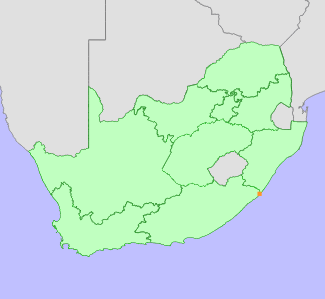|
Scientific Name | Lydenburgia abbottii (A.E.van Wyk & Prins)Steenkamp, A.E.van Wyk & Prins |
Higher Classification | Dicotyledons |
Family | CELASTRACEAE |
Synonyms | Catha abbottii A.E.van Wyk & M.Prins |
Common Names | Pondo Bushman's Tea (e) |
National Status |
Status and Criteria | Endangered D |
Assessment Date | 2022/02/28 |
Assessor(s) | L. von Staden & A.T.D. Abbott |
Justification | This is one of the rarest trees in South Africa, known from two river gorges less than 10 km apart. There are four subpopulations, each with fewer than 50 mature individuals. The total population is therefore estimated as fewer than 200 mature individuals. There are no serious threats likely to cause a continuing decline at present. |
Distribution |
Endemism | South African endemic |
Provincial distribution | Eastern Cape, KwaZulu-Natal |
Range | This species is restricted to two adjacent river gorges on the KwaZulu-Natal-Eastern Cape border. |
Habitat and Ecology |
Major system | Terrestrial |
Major habitats | Scarp Forest |
Description | Plants grow in scarp forest on sandstone, in deep river gorges, along rocky stream banks and drainage lines. |
Threats |
| Lydenburgia abbottii is found deep within ravines and river gorges where it is relatively safe from the main threats to Pondoland forests (too frequent and intense grassland fires and wood harvesting) which impact on forest margins (T. Abbott pers. comm.). Although specimens of L. abbottii would be considered a good source of timber, the inaccessibility of the habitat would make it extremely difficult to extract harvested wood and therefore this is not considered a serious threat.
Scott-Shaw (1999) mentions lack of recruitment as a potential threat. However, Styles 2026 (NH) notes the presence of juveniles on a tributary to the Mzamba River. The population is also maintained by vigorous coppicing around the base of older trees (T. Abbott pers. comm.). |
Population |
There are four known subpopulations, all very small, consisting of fewer than 50 mature individuals. This species is not suspected to be declining.
|
Population trend | Stable |
Conservation |
| This species is protected in the Umtamvuna Nature Reserve. The largest proportion of the population however occurs in unprotected tributaries of the Mzamba River. Given that this is one of the rarest trees in South Africa, even individuals outside of the Umtamvuna Nature Reserve require special protection (T. Abbott pers. comm.). |
Assessment History |
Taxon assessed |
Status and Criteria |
Citation/Red List version | | Lydenburgia abbottii (A.E.van Wyk & Prins)Steenkamp, A.E.van Wyk & Prins | EN D | Raimondo et al. (2009) | | Catha abbottii A.E.van Wyk & M.Prins | EN | Scott-Shaw (1999) | | Catha abbottii A.E.van Wyk & M.Prins | Vulnerable | Hilton-Taylor (1996) | |
Bibliography |
Abbott, T. 2006. The story of the Pondoland Centre. PlantLife 33&34:5-72.
Boon, R. 2010. Pooley's Trees of eastern South Africa. Flora and Fauna Publications Trust, Durban.
Hilton-Taylor, C. 1996. Red data list of southern African plants. Strelitzia 4. South African National Botanical Institute, Pretoria.
Raimondo, D., von Staden, L., Foden, W., Victor, J.E., Helme, N.A., Turner, R.C., Kamundi, D.A. and Manyama, P.A. 2009. Red List of South African Plants. Strelitzia 25. South African National Biodiversity Institute, Pretoria.
Scott-Shaw, C.R. 1999. Rare and threatened plants of KwaZulu-Natal and neighbouring regions. KwaZulu-Natal Nature Conservation Service, Pietermaritzburg.
Van Wyk, A.E. and Prins, M. 1987. A new species of Catha (Celastraceae) from southern Natal and Pondoland. South African Journal of Botany 53(3):202-205.
|
Citation |
| von Staden, L. & Abbott, A.T.D. 2022. Lydenburgia abbottii (A.E.van Wyk & Prins)Steenkamp, A.E.van Wyk & Prins. National Assessment: Red List of South African Plants version . Accessed on 2025/09/19 |
 Comment on this assessment
Comment on this assessment

